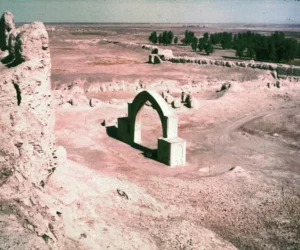Shahr-i Gholghola, also known as the City of Screams, is an ancient fortress city located in the heart of Afghanistan’s Bamiyan Valley. It stands as a testament to the region’s rich history, which dates back to the 6th century AD. The city’s ruins, perched on a steep cliff, overlook the valley and are a poignant reminder of the area’s Buddhist past and the Islamic conquests that followed. Shahr-i Gholghola is part of the cultural landscape and archaeological remains of the Bamiyan Valley, a UNESCO World Heritage site since 2003. The city’s name, meaning “City of Screams,” is believed to derive from the tragic events that unfolded during the Mongol invasion in the 13th century.
Ghurid dynasty
The Ghurid dynasty, flourishing from the mid-12th to the early 13th century AD, was a remarkable period in the history of South and Central Asia. Originating from the Ghor region in present-day central Afghanistan, the Ghurids were initially a tribe of Iranian descent. Their rise to power marked a significant shift in the political and cultural landscape of the region, laying the groundwork for the spread of Islam and the establishment of a network of architectural and scholarly achievements that would influence generations.
The dynasty’s timeline is punctuated by major moments, notably the conquests that expanded their territory far beyond the rugged mountains of Ghor. Under the leadership of Sultan Alauddin Husain (1161-1203 AD), the Ghurids began their expansion, but it was Sultan Ghiyath al-Din Muhammad (1163-1203 AD) and his brother, Sultan Mu’izz al-Din (also known as Muhammad of Ghor), who significantly extended Ghurid influence into northern India, laying the foundation for the eventual rise of the Delhi Sultanate.
Religion played a central role in the Ghurid dynasty, with Islam serving as both a unifying and expanding force. The Ghurids were fervent promoters of Sunni Islam, and their conquests were often accompanied by the establishment of madrasas and mosques, which facilitated the spread of Islamic culture and religious practices. This period saw a significant increase in the conversion to Islam in the regions under Ghurid control.
Social and daily life under the Ghurid dynasty was characterized by a blend of Persian and local cultures. The Ghurids were patrons of the arts and architecture, commissioning buildings that combined Islamic and indigenous designs, a testament to their sophisticated aesthetic sensibilities. Literature, particularly poetry, flourished, with Persian emerging as a language of administration and culture.
The Ghurid rulers were known for their military prowess and strategic acumen. After the death of Sultan Mu’izz al-Din in 1206 AD, the dynasty faced internal divisions and external threats, leading to its gradual decline. The last of the Ghurid strongholds were eventually absorbed by the Khwarazmian Empire and the nascent Delhi Sultanate.
The Ghurids were not only warriors but also builders, leaving behind an architectural legacy that includes the Minaret of Jam, a UNESCO World Heritage site in Afghanistan. This towering structure, adorned with intricate brickwork and Kufic inscriptions, stands as a silent witness to the dynasty’s grandeur and its contributions to Islamic architecture.
Wars and battles were pivotal in the expansion and defense of the Ghurid realm. The Ghurids engaged in numerous conflicts, most notably against the Ghaznavids and later the Khwarazmians. The Battle of Tarain in 1192 AD, where the Ghurids defeated the Chauhan Rajput king Prithviraj Chauhan, is particularly celebrated for opening up northern India to Ghurid influence and subsequent Muslim rule.
Despite their relatively short reign, the Ghurids played a crucial role in the history of South and Central Asia. Their legacy, marked by the spread of Islam, architectural innovations, and the fusion of Persian and local cultures, left an indelible mark on the region’s socio-political and cultural landscape, paving the way for future Muslim dynasties in India.

Fort of Bost (Qala-e-Bost)
Overview of Bost Fort Bost Fort, known locally as Qala-e-Bost, stands near Lashkargah in Helmand Province, Afghanistan. Some believe builders constructed it around 3,000 years ago. The fortification spans approximately 10 kilometers. Many locals and foreign tourists have visited this historical site. Geographic and Cultural Significance The fort is situated at coordinates 31° 30’ 02″…

